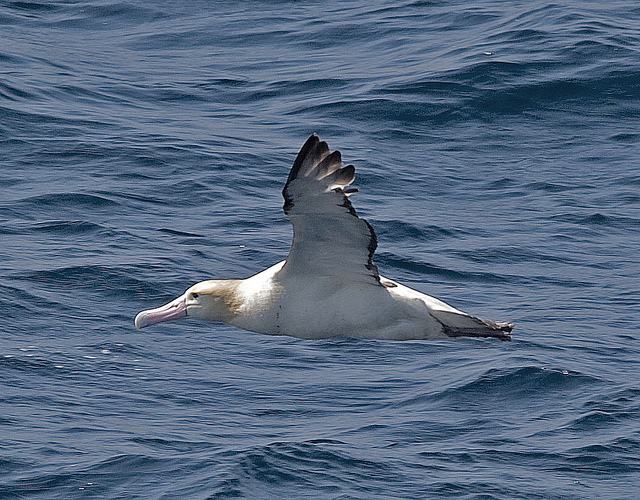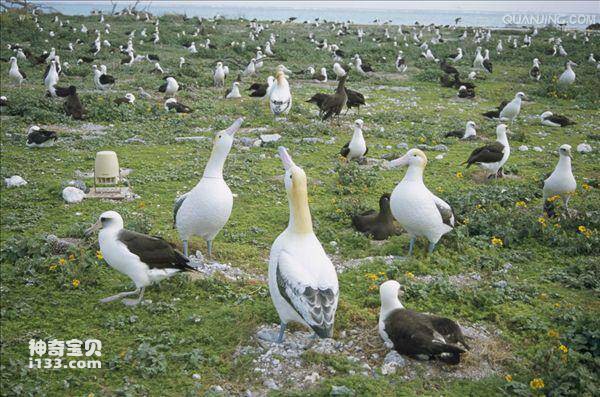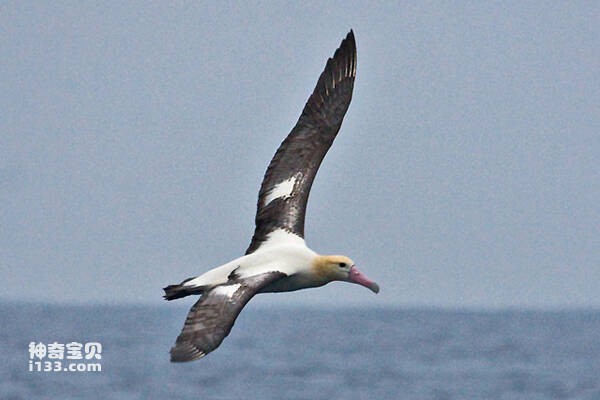Phoebastria albatrus
IUCN
LCBasic Information
Scientific classification
- name:Phoebastria albatrus
- Scientific Name:Petrel, albatross, Short-tailed Albatross
- Outline:Waterfowl
- Family:Procellariiformes Diomedeidae Phoebastria
Vital signs
- length:94-95cm
- Weight:3-4kg
- lifetime:40-60year
Feature
Do not approach ships, resident bird, non-migratory
Distribution and Habitat
Short-tailed albatrosses usually live in the western Pacific Ocean in the North Pacific and Asia, breeding on islands such as the Ogasawara Islands, Ryukyu Islands and Penghu Islands in the ocean. During the non-breeding season, they wander around, from the Kamchatka Peninsula in the North Pacific, the Bering Sea and the waters near Alaska, south along the Chinese coast to Fujian and Taiwan, and down along the western coast of North America to California and Mexico.
Satellite tracking shows that during the migratory breeding period, females live more near the coast of Japan and Russia, while males and young birds live more in the Aleutian Islands, the Bering Strait and the coast of North America. In addition, the daily flight distance of young birds is basically twice that of adults, and they stay on the continental shelf longer than adults.
Distribution in China: Distributed in Shandong (Yantai), Fujian Coast, Taiwan (Taichung), Penghu Islands and Diaoyutai Islands, and breed in
Appearance
The adult short-tailed albatross is the only white albatross in the Pacific Ocean. Its body feathers are white, with yellowish fur on the top of the head, nape and nape of the neck. The longest shoulder feathers, wings and tail tips are dark brown. The wing coverlets are black and white, with a large white spot near the shoulder. The primary flight feathers and tail feathers have yellow-white shafts, and the undertail coverts and armpits are pure white. The bill is long and strong, with a hook at the front, covered with many horny plates, and the tip of the upper bill is bent downward; the two nostrils are tubular and separated to the left and right; the neck and tail are short; the body is thick and strong; the wings are narrow and long, up to 55 cm long, and the tip is curved like a sharp knife. When flying, the feet are extended far behind the black tail.
Color: dark brown iris, pink or yellow bill, blue tip, blue-gray feet, black webbed feet.
The plumage color of the short-ta
Details
Short-tailed Albatross is a large seabird with no subspecies.

Short-tailed Albatross usually moves alone or in pairs. Smaller groups can occasionally be seen in winter or in places where food is particularly abundant. It is good at gliding and often flies over the ocean except during the breeding season. It lives on the sea surface, drifts with the current, can swim, but does not dive. It is alert, solitary and quiet, and generally does not approach ships sailing in the ocean like other types of albatrosses. It needs to flap its wings sharply to take off on the sea surface, and it cannot take off at all on land. It often has to climb to the edge of a cliff or jump down from a high slope to fly.
The short-tailed albatross particularly likes to fly freely in the sky. It has superb skills in controlling the long wind and soaring with the help of wind. Its wings are long and narrow, which can adapt to the changeable air currents of the ocean. With its wings spread, it can stay in the air for a long time without flapping its wings, letting the strong wind blow. The source of its soaring power is mainly the kinetic energy generated by the updraft, especially the unstable updraft over the ocean. The short-tailed albatross generally uses tailwind and downward flight to increase its speed. When it approaches the sea surface, it turns around and rises into the sky by taking advantage of the headwind weakened by friction with the wave crests. It flies repeatedly in this way. Sometimes, it soars into the sky and dives down on the huge waves. It can even move forward unhindered in a storm. It can be said that it lives on the wind.

The short-tailed albatross forages both during the day and at night, especially during the breeding season. It feeds mainly on small mollusks and other marine invertebrates and small fish that live on the surface of the water, and sometimes eats animal viscera thrown off ships, especially waste thrown off by whaling and fishing boats. It can neither fly in the air to catch food nor dive underwater to hunt, and foraging activities are mainly carried out on the water surface. During the wandering period outside the breeding season, they can also forage all day. The food of the chicks is mainly the preliminarily digested food that the adults have swallowed and regurgitated.
The short-tailed albatross is a resident bird that lives in the Asian and western Pacific Oceans and its islands all year round. During the non-breeding season, it occasionally wanders to the eastern Pacific Ocean California, north to Alaska, the Bering Sea and the waters near the Kamchatka Peninsula.
The short-tailed albatross rarely sings except during the breeding season and is usually silent at sea.

The breeding season of the short-tailed albatross is from October to December every year. It breeds on the coastal and offshore islands of the western Pacific Ocean of Asia, especially on isolated islands in the secluded and rocky open ocean. On the rocks of the remote and isolated islands, adult male and female birds come one after another, flapping their beautiful wings and dancing gracefully, while chirping "cluck". The courtship of short-tailed albatrosses is very "elegant". Through frequent contact, they try their best to understand each other. After the shy "proposal" ceremony, a pair of albatrosses become partners.
Short-tailed albatrosses often gather together in pairs to build nests. The nests are mostly placed in depressions on the ground of islands. They are very simple and mainly made of dead grass, moss and soil. They can be used for many years. Both male and female birds have to repair and supplement them before breeding every year. Therefore, as the years of use of the nest increase, it becomes larger and larger.
After the nest is built, the female bird lays a white egg with a slightly rough eggshell. At the blunt end of the egg, there are sometimes some red or ochre spots. The egg size is 98.1-120.7 mm × 56-86 mm, with an average of 108.3 mm × 70.3 mm. The male and female parents take turns to incubate the nest until the chicks hatch. The incubation period of the eggs may take 75-82 days. There is an "incubator" formed by folded skin on the abdomen of the parent bird, which can hold the eggs. It is both safe and warm, so although the number of eggs laid is small, the hatching success rate is relatively high.
The short-tailed albatross has a long brooding period. During the long winter, the parent bird needs to carefully raise its offspring and feed the chicks with food that it swallows, digests initially and regurgitates. The chicks are born between January and February. They are covered with light down at birth. After the down is shed, they become young birds with a layer of curly thick hair. From the end of May to the beginning of June, when the young birds grow stronger and stronger and their bodies begin to become smooth and white, the male and female parents fly away, leaving the young birds to spend the winter by consuming the fat stored in their bodies.
The young birds of the short-tailed albatross have a special ability, which is to cool the undigested fat and residues in the body to form a large amount of pink "stomach oil" composed of triglycerides and lipids, which is like spermaceti, and concentrates on the outside of the stomach epithelial cells. Whenever they are attacked, they spray out the "stomach oil" to drive away the natural enemies. The "stomach oil" can also replenish the tail fat glands to clean feathers. After about 270 days, the young birds can independently learn to take off with strong wings and then bravely fly to the sea to live. However, its sexual maturity process takes 9-12 years.
Short-tailed albatrosses can live up to 40-60 years. They can fly at sea for 5 years before returning to the island where they were born. Pairing is lifelong, usually starting at the age of 6.
The short-tailed albatross has a small population and a narrow breeding distribution area. It has been listed in the World Red List of Endangered Animals and the World List of Endangered Birds. China has also listed it as a national key protected wild animal as a first-class animal protection. Due to volcanic eruptions and people's large-scale capture, the number has been decreasing. Especially at the end of the 20th century, due to the increase in commercial demand for feathers and two large-scale volcanic eruptions on the southern islands of Japan in 1902 and 1939, the short-tailed albatross was almost extinct.
In the 19th and 20th centuries, the activities of Japanese feather collectors led to a rapid decline in the population of the short-tailed albatross, and it was recognized as extinct in 1949, but was later discovered again in 1951.
In the early 21st century, tens of thousands of albatrosses were threatened with death, and they were often caught in the hooks on the fishing lines used to catch tuna, swordfish and bottom-dwelling fish. The fishing lines are more than 130 kilometers long and have thousands of baited hooks on them. Before the fish sink into the water, birds such as albatrosses, petrels and shearwaters often chase after them to catch food and fall into the trap. Every year, nearly 30 species of seabirds, about 180,000, are killed by the fishing method called "longline fishing" around the world. The short-tailed albatross is one of the biggest victims of longline fishing. If the situation is not restricted, they will soon become extinct.
The use of drift nets in fisheries has also killed many seabirds, including short-tailed albatrosses. The general concern about fisheries in the world led the United Nations to decide in 1992 to ban the use of drift nets for fishing. However, the situation of longline fishing killing albatrosses and other seabirds has not been properly resolved, but there are many ways to greatly reduce the death of albatrosses and other seabirds, including laying out the line underwater so that seabirds cannot touch the baited hooks, the pennant above the hook fluttering in the wind can scare away most seabirds, laying the hook at night can protect the albatross from harm, and quickly pulling the hook can also play a part.
Other threats: natural disasters (such as typhoons), predators in gathering places, marine pollution (such as oil pollution), and the overlap between the distribution area of short-tailed albatrosses and fishing areas.
Countries such as China and Japan have carried out multi-faceted protection work, which has slightly increased the number of short-tailed albatrosses. As people's calls for improving the marine environment become stronger and stronger, the population of short-tailed albatrosses will gradually recover and expand.
Listed in the "China Red Book" assessment level: endangered species (assessment year: 1996).
Listed in the "Red List of Chinese Species" Assessment level: NA, not suitable for assessment, based on the standard: China's distribution edge.
Listed in the "Taiwan Bird Red Book" Assessment level: Endangered species.
Listed in Appendix I of the 2019 edition of the Convention on International Trade in Endangered Species of Wild Fauna and Flora (CITES) Appendix I.
Species assessment levels in the United States and Japan: EN, endangered species.
Listed in the Convention on the Conservation of Migratory Species of Wild Animals (also known as CMS or Bonn Convention): Appendix 1 (assessment year: 2008).
Listed in the IUCN Red List of Threatened Species: VU, vulnerable species (assessment year: 2012).
Listed in China's National List of Key Protected Wildlife (February 5, 2021) at level one.
Protect wildlife and eliminate game.
Maintaining ecological balance is everyone's responsibility!








